Easy & Hi-Protein Vegan Kimchi Jjigae Reigns Supreme.
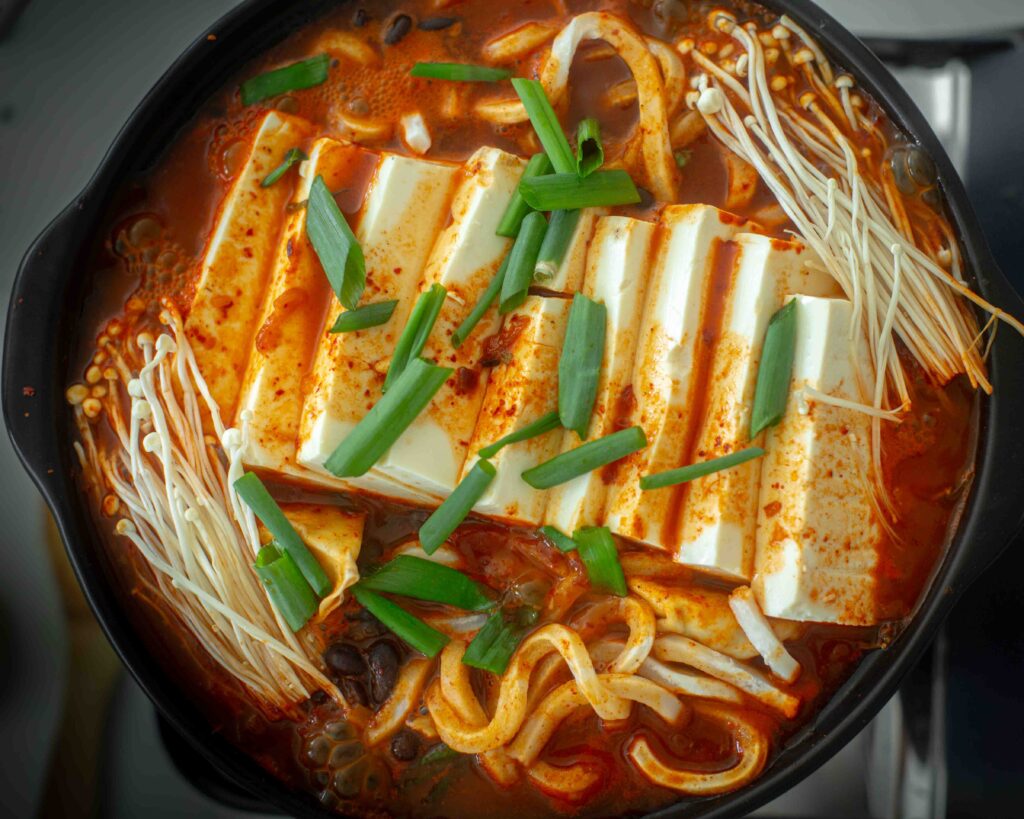
Easy. Hi-protein. Vegan.
These three words are why this vegan kimchi jjigae recipe reigns supreme.
Guys. I made this kimchi jjigae two days ago in preparation for this blog post and I kid you not:
It was the BEST F*CKING KIMCHI JJIGAE I’VE EVER EATEN.
EVAR!!
Now that you have the best homemade vegan kimchi you’ve ever eaten, it’s time to cook something with it.
Let’s get jjigae with it!
(My husband made me say the above.)
- What Is Kimchi Jjigae?
- Why You’ll Love This Vegan Kimchi Jjigae Recipe.
- Key Ingredients & Notes on Substitutions for this Hi-Protein Vegan Kimchi Jjigae.
- Fun Add-ins for Your Vegan Kimchi Jjigae.
- How to Make Hi-Protein Vegan Kimchi Jjigae.
- Storing Your Leftover Vegan Kimchi Jjigae.
- Frequently Asked Questions.
- Questions & Comments
Disclaimer: Some of the links in this post may be affiliate links for products I use and love. If you make a purchase after clicking one of those links, I may earn a small affiliate commission, perhaps enough to buy some extra gochujang or gochugaru 🙂
What Is Kimchi Jjigae?
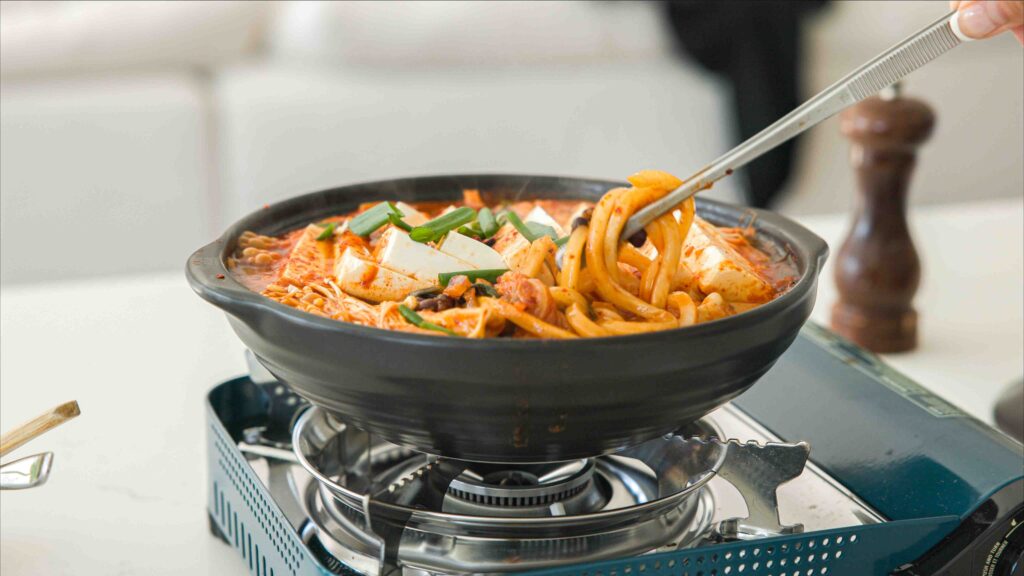
If you’ve ever watched Korean dramas, then you’ll know that kimchi jjigae is a staple food of Korean cuisine. “Jjigae” (sometimes spelled “chigae”) literally means “stew” in Korean. Hence, kimchi jjigae translates into “kimchi stew.” Made with aged kimchi (i.e., napa cabbage kimchi that’s a little more sour than you prefer), vegetables, Korean chili flakes (“gochugaru”), Korean chili paste (“gochujang”), tofu, and other proteins, kimchi jjigae is extremely flavorful and hearty.
But, as the name suggests, kimchi is the main ingredient in this Korean stew, and for that reason, I often think of kimchi jjigae as “Korean soul food.” But because it is such a staple of Korean households, this is not the dish I would order at Korean restaurants. This is the dish that your mom makes for you, the stew you pull together when you’re feeling a little ragged, the comfort food you rely on when times are hard. In other words, it’s something you should be able to make readily for yourself and therefore, it’s not something you pay to have others prepare for you.
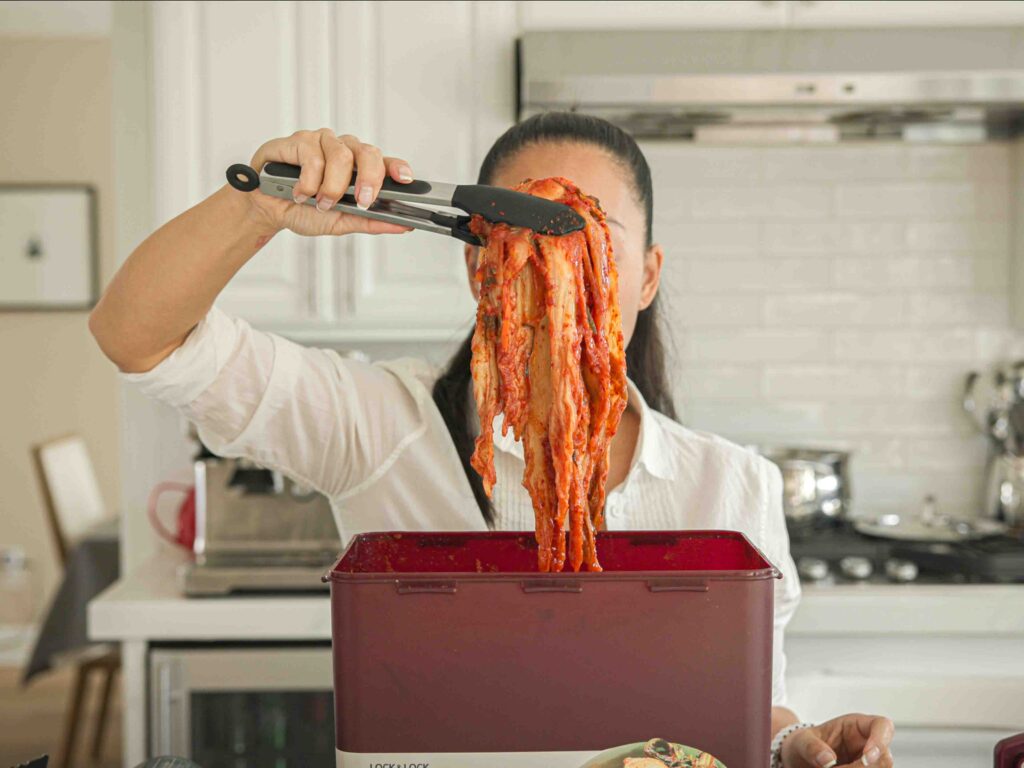
That said, if you’ve ever ordered kimchi jjigae at a Korean restaurant or if you’ve had the pleasure of dining on a traditional Korean meal before, then you know that kimchi jjigae is one of many “side dishes” or “banchan” on a Korean bapsang. While it can certainly constitute a hearty meal in and of itself (given all the veggies and protein), it’s usually served with a bowl of rice and other assorted vegetables and proteins. Its distinct sourness has the ability to cut through rich proteins (like Korean BBQ) while also providing the velvety warmth that is so characteristic of a good stew.
Like so many Korean foods, kimchi jjigae is aimed at making sure nothing goes to waste. Like bibimbap, it’s about taking what’s in your fridge, the stuff you would otherwise not serve at the table, and putting those things into a pot until they become delicious again.
Why You’ll Love This Vegan Kimchi Jjigae Recipe.
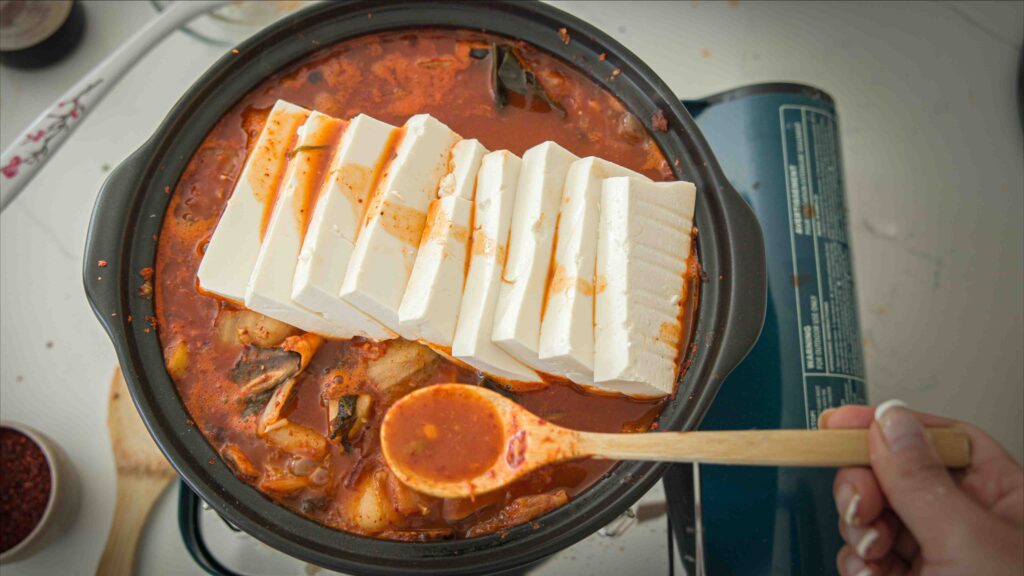
Because it tastes AMAZING.
And it’s super easy to make, full of healthy protein, and draws upon all the rich, spicy flavors of my childhood.
I’ve been eating kimchi jjigae my entire life. I’ve had good kimchi jjigae, really TERRIBLE kimchi jjigae, and outstanding kimchi jjigae. In other words…
I know what excellent kimchi jjigae requires, even if it’s vegan:
- Excellent kimchi
- Flavorful broth
- Nutrient protein
- Spice!
I also know what BAD kimchi jjigae looks like:
- Soggy, mushy kimchi
- Flavorless, bland broth
- Not enough protein
Don’t make my mistakes and subject yourself to bad kimchi jjigae. This recipe is tested and proven to satisfy your kimchi jjigae cravings and impress even the most skeptical, non-vegan Korean ajummah!
Key Ingredients & Notes on Substitutions for this Hi-Protein Vegan Kimchi Jjigae.
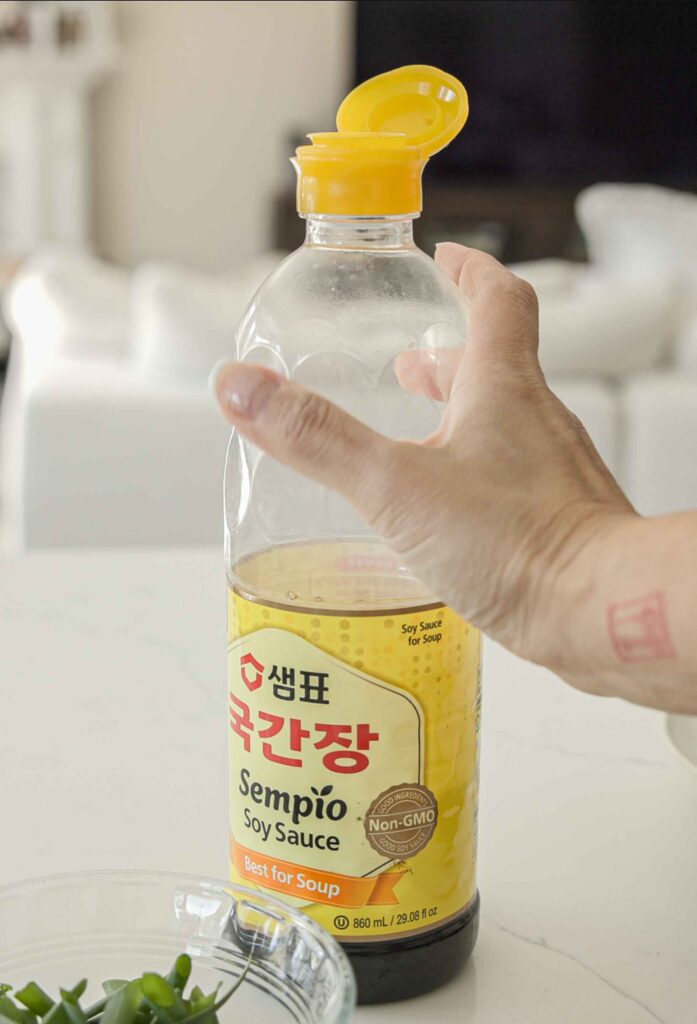
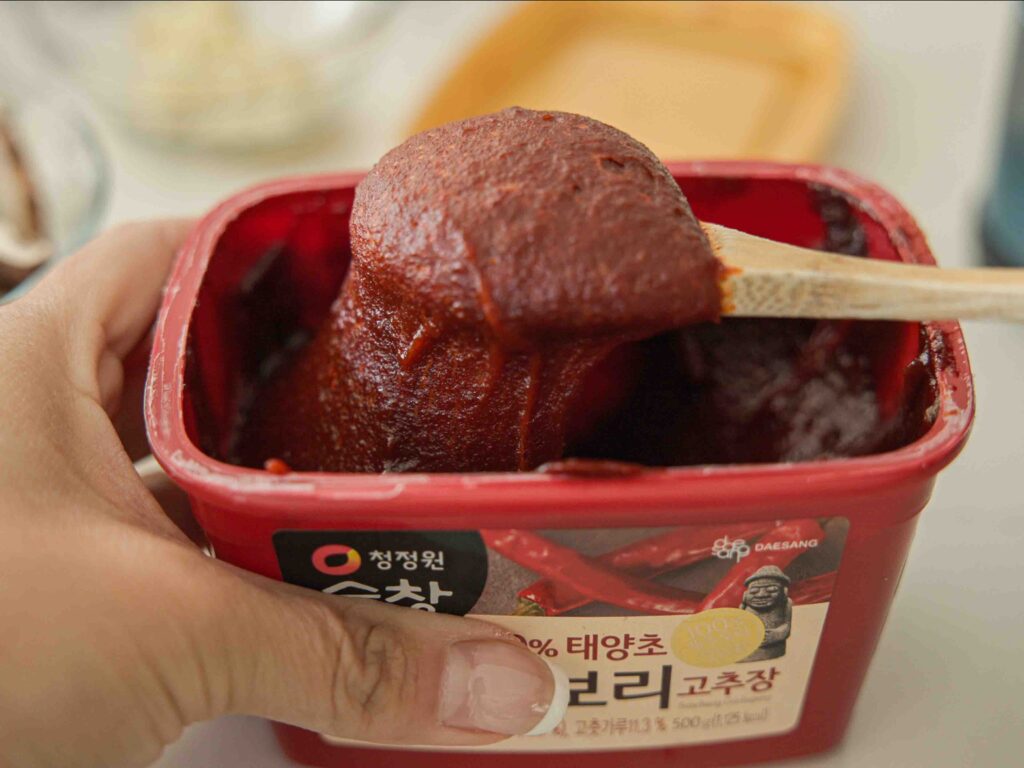
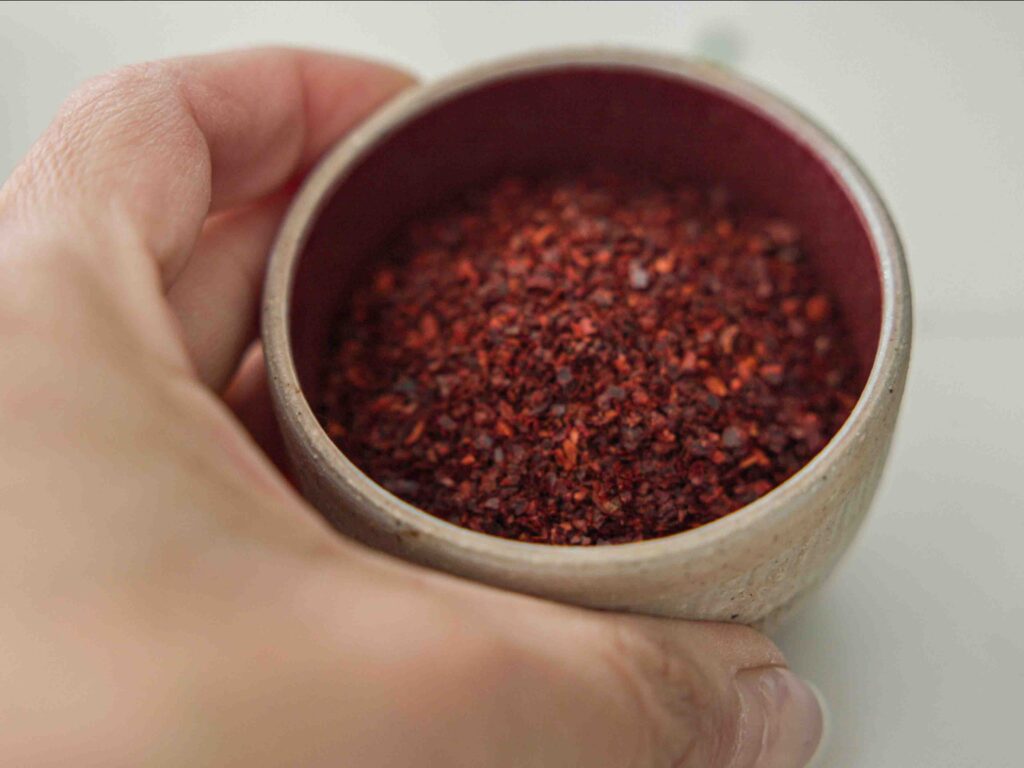
The following are the key ingredients you’ll need, along with notes on substitutions, for this vegan kimchi jjigae:
- Sesame Oil. Toasted sesame oil (not cold-pressed) is often the starting point to many Korean stews, including this vegan kimchi stew. Its rich and sweet nuttiness enhances the other umami flavors typical of Korean recipes. You can usually find toasted sesame oil in the international aisle of your local grocery stores, but you can also find it online. If you do not have toasted sesame oil, you can always substitute with any neutral oil (like avocado oil) or extra virgin olive oil.
- Scallions or Green Onion. You’ll be using the entire scallion–both the greens and the whites–for this vegan kimchi jjigae. Although I also like to add a little regular onion, I’ve found that they can be a little overpowering. I thus like to use the white scallion pieces in the beginning to develop great depth of flavor, while garnishing with the green parts at the end for color and bite.
- Vegan Kimchi. Obviously, you can’t make vegan kimchi jjigae without vegan kimchi! Luckily, I got you on this. Now, if you’re not able to make your own homemade kimchi (I won’t judge you–kimchi making is hard–but I will tell you, your own homemade kimchi will be the best kimchi you’ve ever eaten), vegan store-bought kimchi is also fine. The key to good kimchi jjigae is that your kimchi is old. I’ve tried making kimchi jjigae with fresh kimchi and it was horrible. You want your kimchi to be especially smelly for this vegan kimchi jjigae!
- Kimchi Liquid. If you’ve followed my vegan kimchi recipe, then you should have plenty of kimchi juice at your disposal. That kimchi juice is GOLD! It not only gives this jjigae its characteristic red color, it will impart amazing flavor to your stew! If your jar of kimchi is low on kimchi juice, no worries. You can always just add a little extra kimchi. 😉
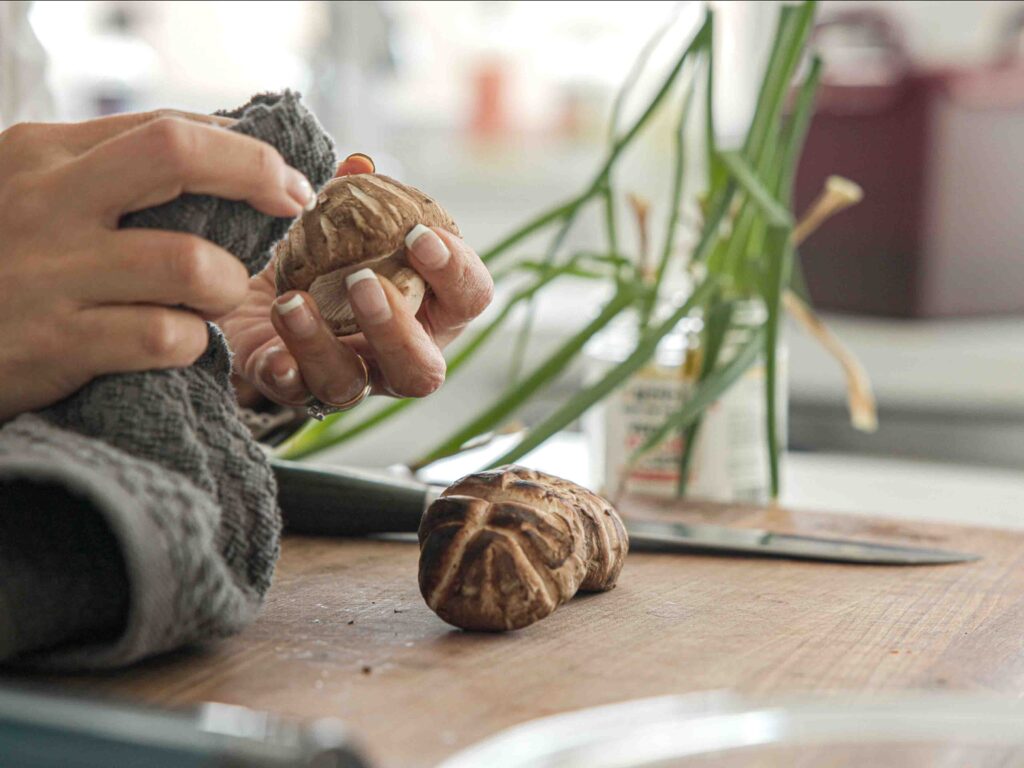
- Shiitake Mushrooms. Traditional kimchi jjigae usually contains pork or some other kind of animal protein. In case it wasn’t clear, this vegan version will not and therefore, we will rely on shiitake mushrooms for both tons of flavor and texture. I like shiitake mushrooms because they are chewier and have a great meaty flavor. You can use dried shiitake mushrooms to create a lovely mushroom broth (simply soak them in some filtered water for a few hours before making this vegan kimchi jjigae) and then use the extra sliced rehydrated mushrooms in the stew. You can also use fresh shiitake mushrooms. If you can’t get your hands on either dried or fresh shiitake mushrooms, you can substitute with whatever mushrooms you have on hand (cremini, button, portobello, trumpet, etc.).
- Potato. Ok. Potato is not a traditional ingredient in kimchi jjigae, but this kimchi jjigae is gonna have potatoes because the author of this kimchi jjigae LOVES potatoes. I would use a nice, waxy potato to avoid mushiness (like a yukon), but you can honestly use whatever potato you like. A sweet potato will affect the flavor and cook time, though, so you’re on your own if you try that.
- Gochugaru. Gochugaru, or Korean red pepper flakes, provide a sweet smokiness to this vegan kimchi jjigae. You can find gochugaru at most Asian markets or online, but if you don’t have gochugaru, you can substitute with gochujang (see next).
- Gochujang. Gochujang, or Korean red pepper paste, gives this stew a rich, umami flavor and heat! Nowadays, you can find gochujang at your local store (I once found it at a convenience store in the middle of rural Michigan, as well as a market in Rome, Italy!) or online, but if you can’t find gochujang, you can substitute with doenjang (fermented soybean paste), miso paste, or, worse comes to worst, tomato paste. Just a note–those two latter substitutions are definitely not Korean and might subject you (and me) to all sorts of accusations using the word “authentic,” but I want to be mindful of the fact that not all of us have a Korean grocery store around the corner!
- Soup Soy Sauce. I’m telling you–my jjigae game got seriously elevated when I started using Soup Soy Sauce for all my Korean stews. If you have my book, then you already know about Soup Soy Sauce. If you don’t have my book, you need to buy my book (see sidebar). Also, Soup Soy Sauce is a lighter colored, cleaner tasting, and more flavorful soy sauce than the condiment you typically find at your favorite sushi place. This one you will NOT be able to find at a non-Korean grocery store, but you can get it online. If you don’t have Soup Soy Sauce, you can substitute with Yondu or regular soy sauce.
- Dashima. Kimchi jjigae is usually made with anchovy broth. This vegan kimchi jjigae will not be using anchovy broth. Instead, we will be “souping up” our vegetable broth (see what I did there?) with a little dried kelp. If you don’t have dried kelp, you can simply omit this ingredient or substitute with mushroom powder or a teensy pinch of spirulina.
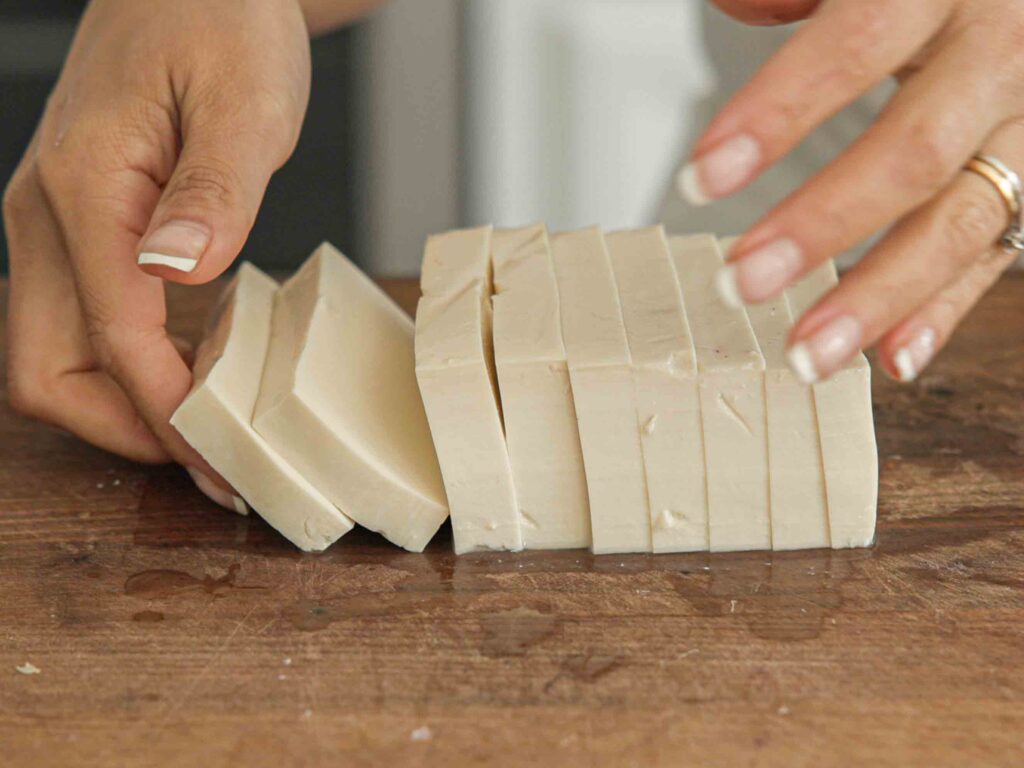
- Tofu. Tofu is not a meat substitute in Korean food. It is its own, beloved ingredient. For this vegan kimchi jjigae, I’m using medium firm tofu, but you can use whatever firmness of tofu you heart desires: all the way from silken tofu, to soft tofu, to extra firm tofu, up to super firm tofu. That said, most traditional recipes for kimchi jjigae call for medium firm or extra firm tofu–i.e., a tofu that can be sliced.
- Black Beans. I know what you’re thinking–black beans?? Look. Vegan kimchi jjigae is already such a healthy dish–tons of vegetables, quality protein, and the probiotic benefits of kimchi (more on that in the FAQ below)–but I wanted a way to add more protein and, of course, my good friend fiber. Black beans were the natural choice for this, packing a ton of fiber-filled protein, as well as a wonderful chewy texture. You can omit them or substitute your favorite legume!
Tip: If you want to keep your spicy vegan tteokbokki gluten-free, make sure to pick up gluten-free gochujang!
Fun Add-ins for Your Vegan Kimchi Jjigae.
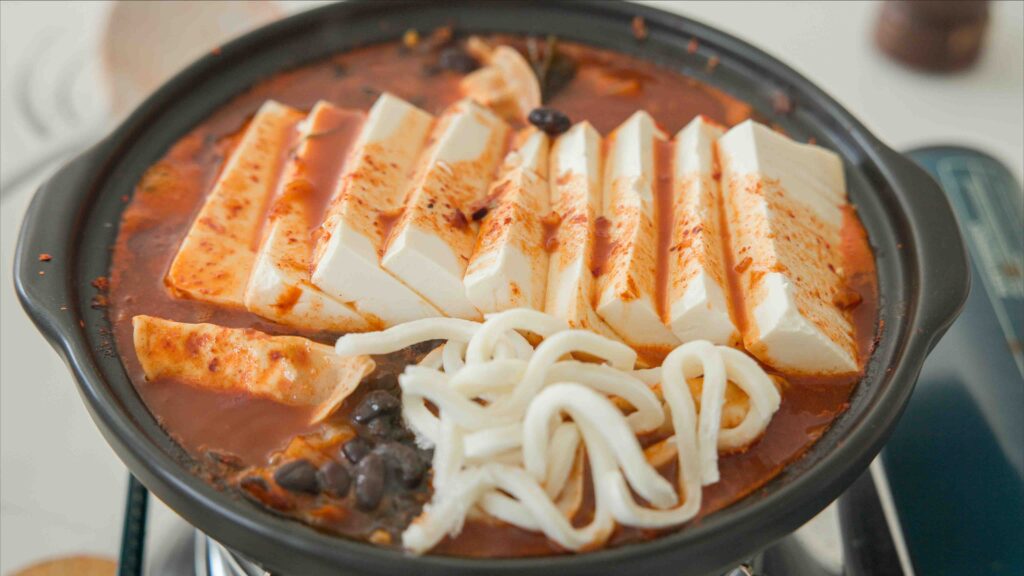
In addition to the above, the following are some optional fun add-ins to your vegan kimchi jjigae:
- Sweet Potato Noodles. I love adding dangmyeon, or sweet potato noodles, to my vegan kimchi jjigae. Don’t add too much, though, as they will suck up all your liquid and you’ll be left with kimchi gravy, not kimchi stew!
- Udon Noodles. Ok, ngl, I got this one STRAIGHT outta my father’s playbook. He LOVES udon and will add it to any liquid. But these chewy, fat noodles are PERFECT for this vegan kimchi jjigae!
- Frozen Dumplings. Drop a couple frozen vegan dumplings in while your stew is bubbling and brewing for some extra protein and carbs!
- Korean BBQ Sauce. The old version of this vegan kimchi jjigae recipe relied on Korean BBQ sauce for extra oomph. I’ve since found that I prefer the delicacy of Soup Soy Sauce and gochujang. But if you like your kimchi jjigae on the sweeter side, add a tablespoon of Korean BBQ sauce!
You can find tips on adding these (i.e., timing) in the FAQ below!
How to Make Hi-Protein Vegan Kimchi Jjigae.
Kimchi jjigae is one of the easiest dishes in any Korean household’s recipe arsenal. Like most stews, you just chop up a bunch of ingredients, throw them in a pot, add water, and let it cook. Done! This vegan kimchi jjigae is no different.
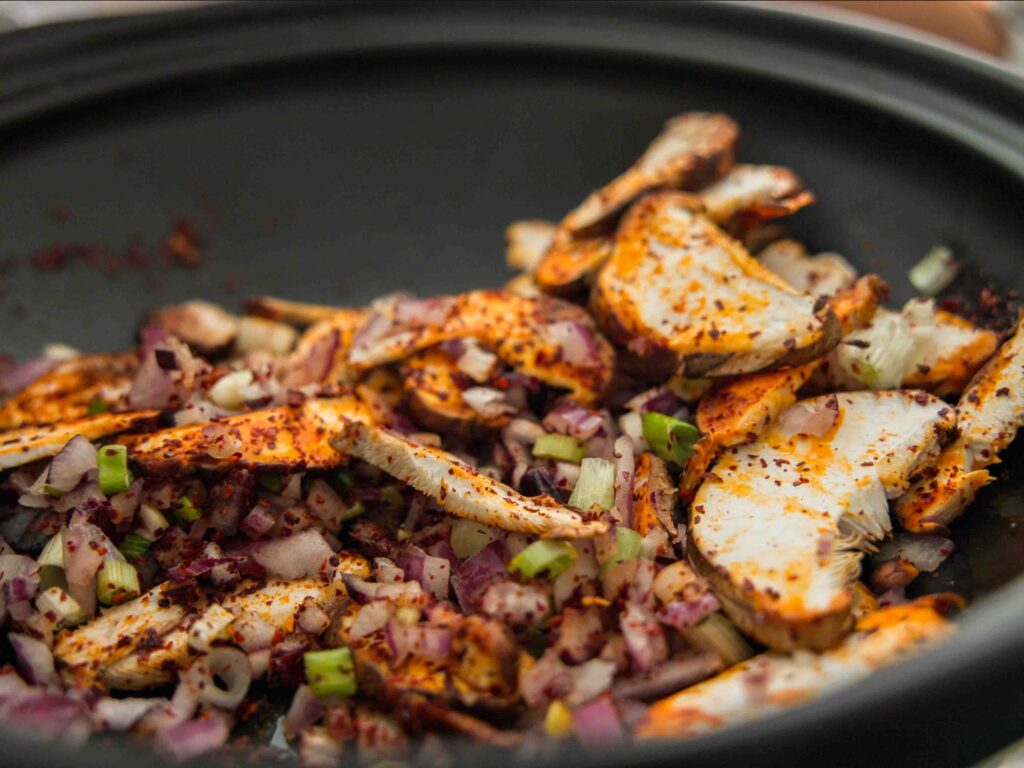
First, add your sesame oil to either a Korean clay pot (“ddukbaeggi”) or small Dutch oven. Before it gets hot, add your gochugaru and stir. This is roasting your chili flakes, to eliminate their sometimes “raw” flavor. Next, add your shiitake mushrooms and cook until they begin to brown. Then, add onions, scallion whites, and garlic. Cook those until the onion gets a little translucent. Next, add your potato and kimchi, along with gochujang. Stir everything together until all your vegetables are evenly coated.
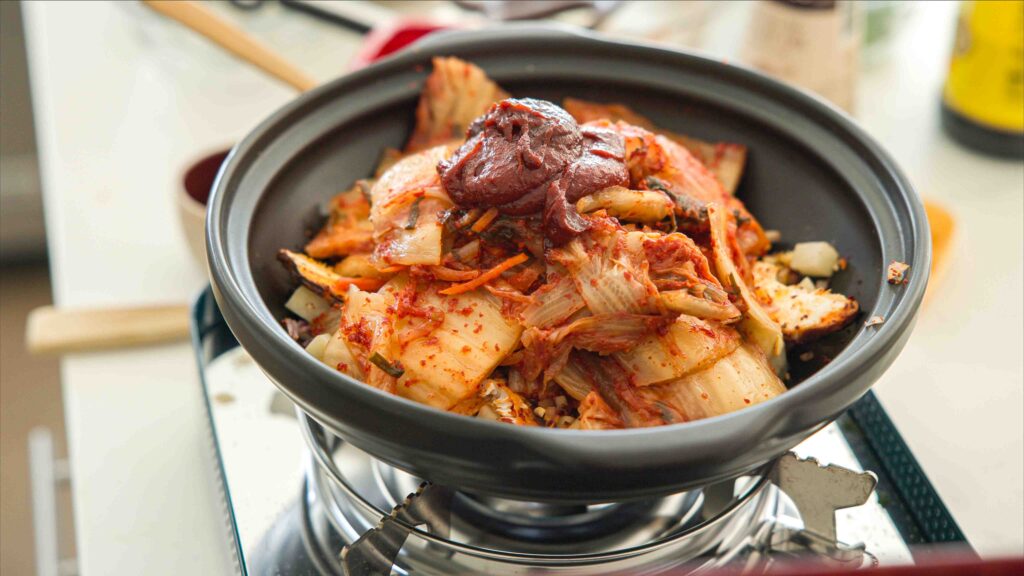
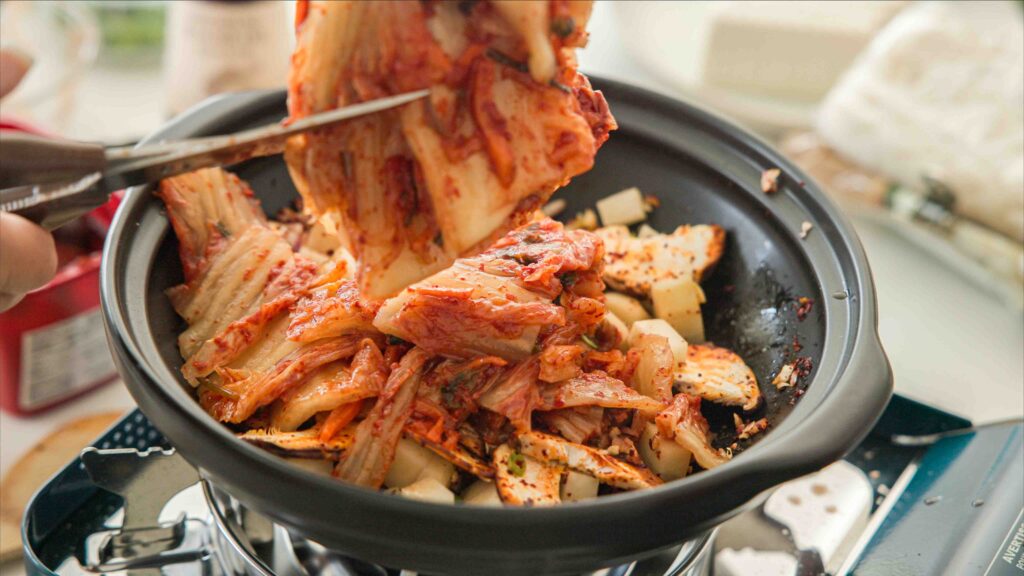
Then, deglaze your pot with a little soy sauce and kimchi liquid. Add water or vegetable broth, along with your dashima, and bring it to a gentle boil. Reduce your heat to allow the soup to simmer until the potatoes are almost cooked (about 10 minutes). Then, add your black beans, along with your beautiful tofu slices, and a few handfuls of enoki mushroom (my new favorite ingredient). Cook for about 3 more minutes on low heat, until the tofu slices have had a chance to absorb some of that gorgeous, fiery broth and your potatoes are perfectly cooked.
You can fish out your dashima or leave it in. These days, I like to just leave it in and eat it for the extra fiber and antioxidants, but if you’re not into that, you can always remove it before serving.
Garnish with scallion greens, an extra drizzle of sesame oil, and get ready for the best vegan kimchi jjigae EVAR!
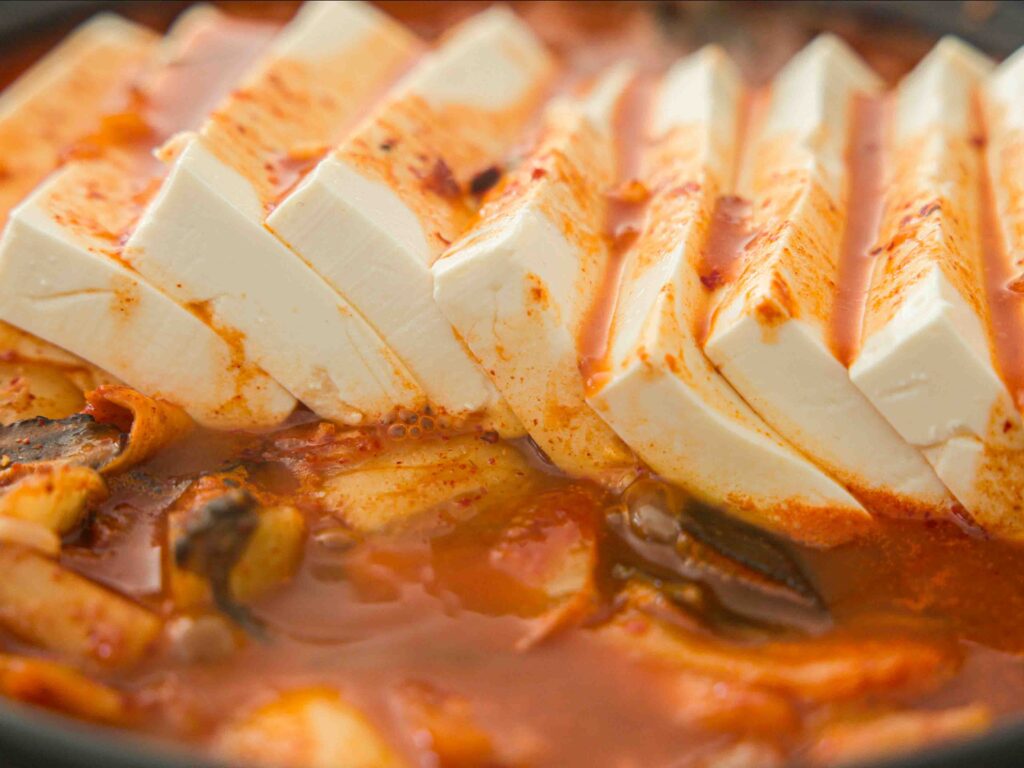
Storing Your Leftover Vegan Kimchi Jjigae.
I almost always have leftover kimchi jjigae when I make this recipe. But the great news is that it tends to taste better the following day! Just stick the leftovers in the refrigerator (my mom will just put the whole pot in the fridge). To reheat, you can add a little water or veggie broth in case you’re running low on broth and then stick on the stovetop over medium heat. You can also just place a bowl of your vegan kimchi jjigae in the microwave.
Your vegan kimchi jjigae should last up to 3 days.
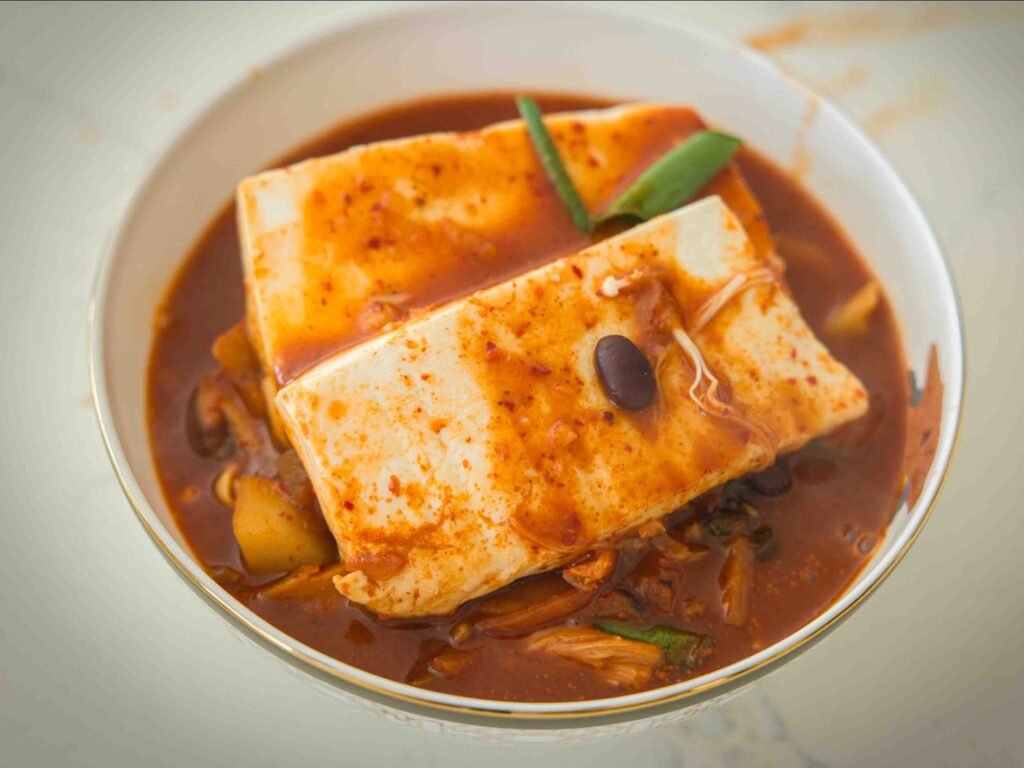
Frequently Asked Questions.
Doesn’t kimchi lose its probiotic benefit if cooked?
While it’s true that cooking kimchi will start to kill the probiotics that kimchi contains, there are a couple reasons why even cooked kimchi retain probiotic benefits. First, it’s unlikely that cooking the kimchi for roughly 13 minutes will kill all the good bacteria. Second, at least one study suggests that even dead probiotics (specifically those killed by heat) still retain significant probiotic value.
What is the difference between kimchi jjigae and soondooboo?
I’ve seen many people get jjigae or kimchi jjigae mixed up with soondooboo. Let’s break it down here at the vocabulary level: “kimchi jjigae” literally translates into “kimchi stew.” Soondooboo refers to a type of tofu–one that is very soft, even softer than silken tofu. Hence, soondooboo jjigae refers to a tofu stew, one that usually doesn’t contain kimchi (though this mashup is quite delicious).
Can I make vegan kimchi jjigae without oil?
Although toasted sesame oil is a key ingredient, you can definitely skip the oil altogether if you’re watching your fat intake. Simply add a little vegetable broth in place of the sesame oil at the very beginning. The rest of the recipe remains the same!
When should I add my “fun add-ins” to my vegan kimchi jjigae?
When to add your fun add-ins will depend a little bit on how long they would individually take to cook. The main objective is to cook until the potatoes are tender; however, you do want to guard against overcooking your kimchi (you don’t want it to be too soggy). Generally, though, the frozen dumplings, sweet potato noodles, and udon–those can be added right after your tofu goes in. For flavor enhancers (e.g., Korean BBQ sauce), you should add those at the same time as the gochujang.
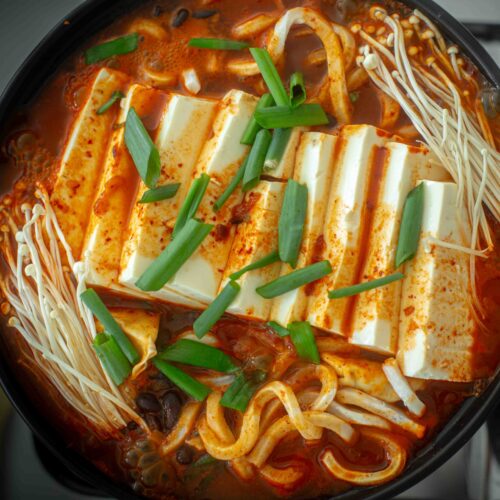
Easy & Hi-Protein Vegan Kimchi Jjigae.
Ingredients
Chigae
- 1 tbsp sesame oil (plus more for garnish)
- 3 large shiitake mushrooms, sliced
- 1/4 cup diced onion
- 3 scallion whites, chopped
- 2 cloves garlic, minced
- 1/2 cup diced potato
- 2 cups aged kimchi, cut into bite-sized pieces (not diced)
- 2 tbsp gochugaru
- 2 tbsp gochujang
- 2 tbsp soup soy sauce
- 1/2 cup kimchi liquid
- 1/2 tsp cracked black pepper
- 2 cups vegetable broth
- 15 grams dashima
- 16 ounces medium firm tofu, sliced intro 1/2-inch thick slabs
- 1 cup cooked black beans
- 3 scallion greens, chopped (for garnish)
- 1 ounce enoki mushroom
Instructions
- To a large ddukbaeggi (clay Korean pot) or medium Dutch oven over medium heat, add sesame oil (or vegetable broth) and gochugaru. Cook for about 1 minute until gochugaru starts to froth. Add shiitake mushrooms and stir until they are coated with oil and gochugaru. Cook for about 2 minutes, until mushrooms start to brown.
- Add diced onion, scallion whites, and garlic until garlic softens and onions begin to throw translucent (about 2 minutes). Make sure to stir regularly, so that the gochugaru doesn't burn.
- Next, add your potatoes, kimchi, gochugaru, and gochujang. Stir all the contents of the pot together until they are all evenly coated. Deglaze your pot with kimchi liquid and soy sauce, stirring so that everything is well-incorporated. Add cracked black pepper. Then, add your vegetable broth (or water). Drop in the dashima and increase the heat to a medium-high until the pot comes to a boil. Then reduce heat to low and allow the pot to simmer for about 10 minutes, until potatoes are almost cooked.
- Add your sliced tofu, black beans, and enoki mushrooms. Cook for an additional 3 minutes, until potatoes are fully cooked. Garnish with scallion greens, an extra drizzle of sesame oil (optional), and remove from heat. Serve with bowl of rice.
Questions & Comments
April 8, 2024
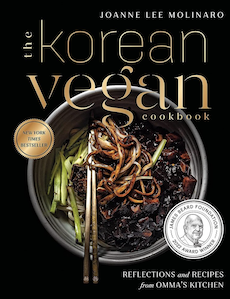
“Hence, soondooboo jjigae refers to a tofu stew, one that usually doesn’t contain kimchi” My local Korean restaurant gives you the option of adding two items to your soondooboo one of them being kimchi. So I always add kimchi and either rice cake or dumplings to mine.
Thanks for so generously sharing your recipes with us.
Made this for dinner tonight. It was really delicious.
Hi there! I made the Omma’s Korean BBQ Marinade for your other tofu recipe and have loads of it leftover… just would like to ask, what would be the best way to store the marinade? Would it be fine if I freeze it?
Hope to hear from you, thanks
Yes, feel free to freeze it, although, honestly, I leave it in my fridge for several weeks. If you use it as often as I do (I put it in EVERYTHING), it won’t last that long!
Whoa! So spicy, so good!